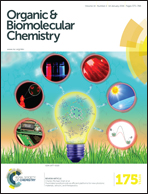Host–guest complexation of di-cyclohexanocucurbit[6]uril and hexa-cyclohexanocucurbit[6]uril with alkyldiammonium ions: a comparative study†
Abstract
The host–guest complexation of symmetrical di-cyclohexanocucurbit[6]uril (Cy2Q[6]) and hexa-cyclohexanocucurbit[6]uril (Cy6Q[6]) with a series of alkyldiammonium ions (H3+N(CH2)nNH3+, n = 2–8) has been studied both in solution and in the gas phase. 1H NMR data indicate that all alkyldiammonium ions have inclusion interactions with both hosts except for the ethanediammonium ion. In addition, if the alkyl chain of the alkyldiammonium ion is longer than n = 5 methylene groups, compressed conformation may occur, which depends on the cavity shape of the hosts and the length of the alkyl chain. Isothermal titration calorimetry (ITC) studies point out that the host–guest complexations of both hosts with the latter five alkyldiammonium ions are enthalpically driven. The comparison of the thermodynamic data reveals that the enthalpies of the van der Waals interactions contribute more to the host–guest complexation enthalpy than the ion–dipole interactions. The enthalpic gain arises from the van der Waals interactions and the reduction of entropy upon the host–guest complexation is strongly affected by the cavity shape of the host. Gas phase structures of long alkyldiammonium guests within both hosts are completely different from those in aqueous solution.
![Graphical abstract: Host–guest complexation of di-cyclohexanocucurbit[6]uril and hexa-cyclohexanocucurbit[6]uril with alkyldiammonium ions: a comparative study](/en/Image/Get?imageInfo.ImageType=GA&imageInfo.ImageIdentifier.ManuscriptID=C5OB01982F&imageInfo.ImageIdentifier.Year=2016)

 Please wait while we load your content...
Please wait while we load your content...